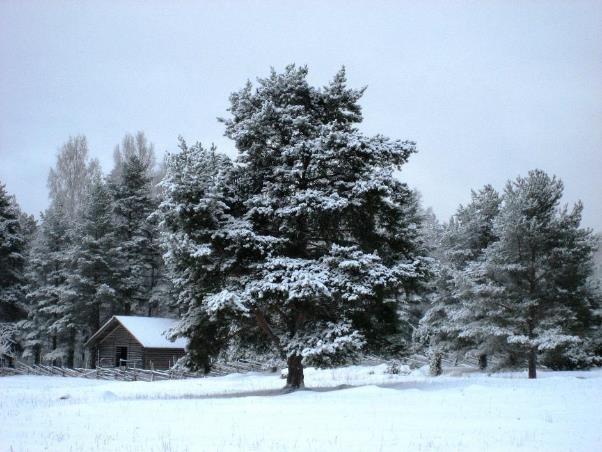Traditional rural biotopes such as wood pastures are among the most biodiverse habitats in northern Europe. With proper management, grazed areas have in general higher biodiversity compared to areas without grazing, and therefore it is very important to maintain the grazing management. An appropriate grazing pressure is important as grazing at intermediate pressure has in general a positive impact on biodiversity. In Finland, inventories estimated that only about 1% remains of the traditional rural biotopes which were present in the 1800s.
Many plant and animal species associated with traditional rural biotopes are threatened. Forest and wood pasture grazing was still common in Finland in the 1930s, but disappeared almost completely in the 1950s with the intensification of agriculture and forestry. A more recent problem in Finland is that the number of farms is decreasing and currently only about 50% of the remaining traditional rural biotopes are managed. On many occasions the whole farm stops its activity or the farm stops livestock husbandry and changes to crop/grass production or indoor livestock production.
There would be, however, a range of opportunities to generate additional farm income from traditional rural biotopes such as e.g. ecotourism, therapy and well-being services (Greencare), wild berry and mushroom cultivation, honey production, bioenergy production and direct sales of pasture meat.
 |
|
Wood pasture in eastern Finland |
Management
There are different kinds of traditional rural biotopes such as forest pastures, wood pastures, wooded meadows, old slash-and-burn cultivation areas, herb-rich meadows, riparian and flooded meadows, fen meadows and moorlands. In the olden days, many of these traditional rural biotopes were used for grazing and nowadays many of these areas would still be very good grazing areas. Because these biotopes are very different, there is no single management method what fits all of them. Therefore, it is important to take into account the biological and cultural history values for planning the best possible management. It is also important to take into account the management objectives. For example, there are different management alternatives for maintaining cultural history, scenic beauty, biodiversity or economic production.
 |
|
Old stone walls add to the cultural history value of wood pastures |
If a wooded area hasn’t been grazed for a long time, tending or clearance of dense vegetation is needed before grazers can be introduced and this may create significant costs. However, initial clearance may also generate income as the harvested shrubs and trees can be sold as timber, firewood or wood chips. Fencing of the area also creates significant costs. Farmers can apply for compensation for the initial clearance and fencing. Tending and grazing opens up the forest so that more light comes in which will create a more favourable and warmer micro-climate. In addition, grazing creates disturbance which creates conditions so that new species can appear. Grazers have the habit of feeding on fast growing abundant species, resulting in a gradual appearance of more rare species. The combination of these factors results in wood pastures that have a high diversity. However, pastures would need continuous management. The initial improvement in diversity can only be observed after a few years and the grazing management should continue. If the management stops, wood pasture vegetation returns to more dense forest vegetation, which generally has lower diversity compared to more open wood pastures.
 |
|
Wood pasture on the shores of lake Haukivesi |
Grazing is in general more efficient for preserving biodiversity compared to mowing. However, grazed pastures and meadows for hay making have a different species composition so in that way they also complement each other. Therefore, biodiversity probably benefits most in a mosaic landscape of pastures and meadows.
Different combinations of grazers have a different impact on biodiversity. This difference is because horses, cows and sheep prefer to eat different species. It is also beneficial for biodiversity to change the grazing species for some period or to put several grazing species together in the same area. However, not all grazers like the same kind of habitat. For example, horses do not like wet areas while cows do.
 |
|
Wooded meadow for hay making |
The grazing bank (laidunpankki)
Nowadays not every farm owns livestock and not every livestock farm has access to natural pastures. The Grazing Bank online service www.laidunpankki.fi offers help in finding animals and grazing areas. The web service also contains practical management information on natural grazing.
GreenCare / herder holiday
For developing a rural tourism business, it is worth considering autochthonous traditional livestock breeds, even though they may grow slower and may be less productive. Farm visitors will appreciate traditional breeds and direct sales of the meat will add to the farm income. In addition, use of traditional livestock breeds adds to the history of the place and some visitors may keep on coming back.
Environmental agreements
Farmers can apply for compensation for managing key biotopes and traditional rural landscapes. Environmental agreements are made for a period of 5 years and the compensation amounts to 450 €/ha/year. If the area is a traditional rural biotope of national or regional value, compensation amounts to 600 €/ha/year. In this case, an inventory of the area and a management plan is required. Supplementary feeding, and use of fertilizer and pesticides are not allowed. Commercial forestry areas are not eligible for subsidies. More information from the Agency of Rural Affairs www.mavi.fi
 |
|
Wood pasture in winter |
Check this article in a pdf format here











